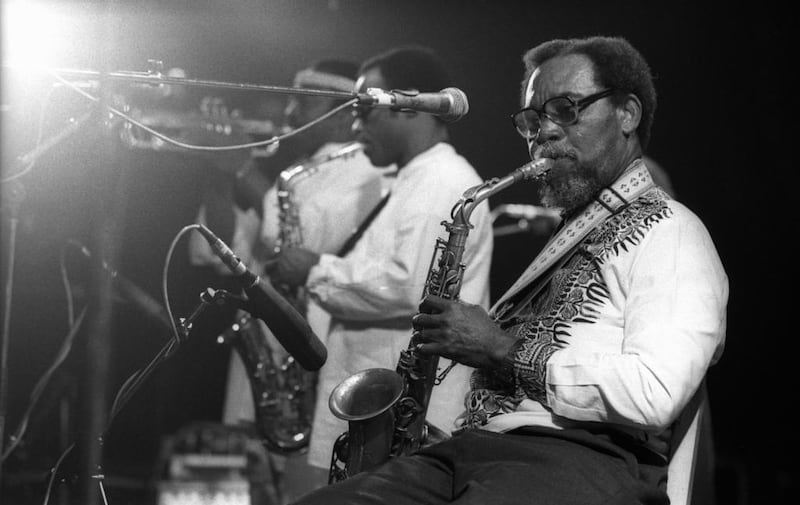Halfway through John Collins’s love letter to highlife, West Africa’s oldest and most enduring form of popular dance music, we meet Sir Victor “Guitar Boy” Uwaifo, perhaps the most flamboyant and fascinating highlife giant of them all.
Formerly a semi-professional wrestler, Uwaifo is a teetotal Nigerian whose on-stage poses sometimes recalled those of Jimi Hendrix. A true renaissance man, he would go on to found his own music academy, art gallery and private television studio, and to publish poetry and philosophical essays.
The Jeromi Hotel that Uwaifo built in Benin City in 1971 housed his own sculptures and artworks. It also took its name from his 1969, Gold Disc-awarded single Jeromi, a fantastical tale of a boy who climbs a magical palm tree to hell and there battles with a two-headed giant.
In his book Highlife Giants: West African Dance Band Pioneers, Collins recalls how, in 1975, he lodged with Uwaifo at the Jeromi, then saw him perform at his newly opened discotheque, Club 400, where “two ‘little people’ playing wooden claves and maracas” traversed the stage and darted in-between Uwaifo’s legs.
Uwaifo wore “spectacular clothes of his own design” and played xylophone, flute and electric organ with his chin. But the virtuoso’s main instrument, the author stresses, was the “double ‘Siamese’ guitar that he would spin around a pivot on his belt”.Though Collins’s rigorous, historically valuable book is sometimes much dryer than the vivid account above might suggest, there’s no question that he’s uniquely well-placed to tell the story of highlife music while celebrating the lives of its key exponents.
A naturalised Ghanaian of British descent and a professor of music at the University of Ghana in Legon, Collins has interviewed – and played with – many of the figures he profiles. He also appears Zelig-like across the decades in several of his book’s many evocative photographs.
The opening chapters find the author unpicking the tight knot of indigenous music forms and cross-cultural influences that begat highlife in Ghana at the turn of the 20th century. Ghanaian brass bands incorporating motifs from native “adaha” music, the coastal guitar/accordion music known as “osibisaaba” and the inland “palm wine” acoustic guitar style (so called because it was played at village events where the said beverage was drunk) all fed into the highlife sound.
Afro-Cuban, European, American and “in some cases, Islamic” influences also played their part, as did the (gradual) introduction of western instruments. But it wasn’t until the mid-1920s, Collins says, that the name “highlife” was coined. He quotes drummer Kofi Ghanaba’s recollection that, for some, the term was associated with “middle-class Africans who wore tuxedos and ‘played the white man’ for the night”. Classic-era highlife saxophonist Yebuah Mensah cites another derivation, namely that highlife “was a term coined by the poor who gathered at the exclusive clubs to enjoy a free show on the pavements outside”.
Genteel and elite as the music’s origins seemingly were, big-band highlife would become a highly-politicised music of the people. Key bands such as Accra’s The Tempos took highlife to Nigeria, Sierra Leone, Guinea and Liberia in the late 1950s, and, as Collins states, highlife was “the soundtrack of the early independence era for many newly emerging African nations”.
The Tempos’s ace alto-saxophonist ET Mensah, sometimes dubbed the “King of Highlife”, is another of the many figures Collins profiles. One of seven children, Mensah grew up in a house containing ancestral shrines overseen by the family’s traditional priest or “wulomo”.
The wulomo held that playing music or even whistling in the presence of these shrines would antagonise deceased ancestors, who would then appear in the house reincarnated as snakes. However, ET and his elder brother Yebuah’s love of music was such that they defied their wulomo, enduring beatings from him as punishment. In 1957, when Ghana achieved full independence from Britain, Mensah composed his famous song Ghana Freedom to commemorate the event, and he was in Guinea with The Tempos in October 1958 when the country gained independence from France. Mensah’s status and influence was such that, when he died in Ghana in 1996, he was given a state funeral.
Highlife Giants is also fascinating on the scarcity of female performers in early highlife music. Vida Hynes, who sang with highlife concert parties in the 1960s, recalls that some band managers thought women might bring bad luck if they touched any of the band's instruments. There was also a widely-held, grossly unfair, assumption that any female musical performer had loose morals and Hynes's parents were once so determined to stop her travelling with the Okutiekus concert party that they had her locked in a police cell.
Other female voices such as that of sometime Tempos vocalist Julie Okine just wouldn’t be silenced, however. Indeed, Collins cites Okine’s 1950s highlife-calypso recording of Nothing But A Man’s Slave as Ghana’s first feminist pop song.
As the book unfolds, we get fascinating glimpses of visits made to Ghana by Afro-American stars such as jazz trumpeter Louis Armstrong and the “Godfather of Soul” James Brown.
Armstrong first visited Ghana in 1956, where a troupe of local highlife trumpeters serenaded him off the plane. But it was 1960, during his second African tour, that Armstrong presented leading highlife musician Eddy Okonta with a trumpet that had a gold mouthpiece. As Collins continues his roll call of highlife giants with palpable affection, there is no shortage of glamorous-sounding musicians with fascinating life stories. We learn of Nigerian vocalist and trumpeter Victor Olaiya, the so-called “evil genius” of highlife, and of Robert Olabinjo Shobowale Benson. “Bobby” to his friends, Benson was a Nigerian who served in the British Merchant Navy. When his ship was torpedoed by a German plane during the Second World War, Bobby spent 32 days at sea in a lifeboat before being deposited on the Cape Verde Islands where a woman named Thunderlio taught him to play guitar. It’s not the kind of back-story you hear on Pop Idol.
Naturally, Collins also maps the gradual decline of classic-era highlife music. In Nigeria, this was hastened by the Civil War of 1967 to 1970, where devastation and post-conflict austerity prompted a move away from the expensive-to-run big bands and towards smaller highlife guitar acts. But in Nigeria and elsewhere, the advent of new technologies and preferred forms of entertainment in the 1980s and 1990s was just as corrosive.
The book closes optimistically, with Collins exploring various factors that are currently driving a highlife revival in West Africa. It helps, he points out, that tourists like its “authenticity”, there has been a spate of highlife re-releases by record labels such as Evergreen, and young hiplife musicians (think fusion of hip-hop and traditional Ghanian sounds) are sampling the highlife giants and spreading the word.
James McNair writes for Mojo magazine and The Independent.





